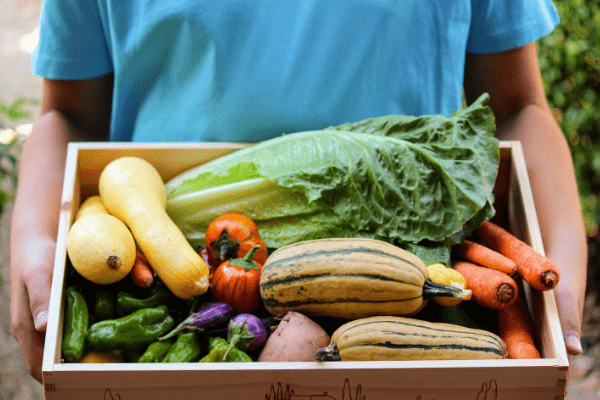The COVID-19 pandemic both accelerated demand for locally grown food and pushed people to e-commerce in droves. These dual forces have created a huge opportunity for farmers and ranchers to sell directly to consumers, chefs, schools and other customers online.
Trouble is, most farmers aren’t natural-born marketers or experienced at direct sales. For many, the whole idea is scary. But with 93% of Americans buying products online last year and more people wanting relationships with local producers, farmers should strongly consider tapping into this booming market.
But they don’t have to go it alone. FFI offers a wealth of resources to guide farmers in this area. So does Barn2Door, by providing software and services to help them manage and grow direct sales. Tera interviewed company COO James Maiocco for the latest podcast, and he shared a trove of data-supported tips and best practices. Here are eight:
1. Go omnichannel. Buyers don’t just go to farmers’ websites—they engage with them through email, social media, Nextdoor and other avenues. “Buyers are on every channel, and your farm can’t afford to do business on just one,” says James, adding that the most successful farmers sell via two to three channels.
2. Rely heavily on email (it’s free!). “Email is an incredibly effective marketing vehicle for farmers,” James says. “It doesn’t cost anything to send, and with a solution like Mailchimp, you can get started for free.” When farmers email customers once a week and include their product catalog, he says sales increase 30%.
3. Make purchasing easy. To make an omnichannel strategy work, farmers need to include a call to action on every webpage, e-newsletter, email, etc. A simple, clickable “shop” or “buy now” button does the trick. “Buyers don’t want to phone, text or email, which take about seven to eight touches to finish a transaction,” James says. “To grow and be successful at any scale, you need to make it super easy to purchase, because people shop at all hours of the day.”
4. Eliminate barriers. Avoid roadblocks such as requiring customers to register or enter a password before purchasing. Otherwise, farmers will “lose about 60% of all buyers who come to the website because they’re required to complete two, three, five or seven steps before they’re even allowed to put an item in the cart,” James says. “They should be able to show up and buy.”
5. Encourage subscriptions. One-time purchases create a lot of work for farmers, because they must constantly go after the sale and remind people to shop. To make it easier, invite customers to subscribe to recurring boxes or orders, which can be tailored to different audiences. “This allows you to streamline operations, harvest dates and pick-pack lists, saving you time and money,” James explains. “We have testimonials about how farmers’ lives have changed simply from moving from scattered one-time purchases to recurring purchases.”
6. Think small. James says many farmers make subscription boxes too big, mistakenly assuming every customer has a family or a chest freezer. Then when they can’t consume the food fast enough, it goes bad and they stop buying. James says farmers who package for singles, couples and people with regular freezers sell out more often and earn about twice as much as those who offer only large subscription boxes or quarter, half or whole animals.
7. Nix mix-and-match. Farmers often want to allow subscribers to customize their boxes, but the data say don’t do it. “If you give people too many choices, conversion goes down,” James says. “But if you say ‘here’s our recommended salad mix’ or ‘here are the types of products you’ll get every week,’ conversion is about ninefold higher just because it’s point-and-click.” Plus, box assembly becomes faster, easier and cheaper.
8. Charge for delivery. Some farmers question whether customers will pay for delivery, but data show that they absolutely will pay $5, $10 or even $15, depending on order size. Barn2Door just published a free e-book all about optimizing delivery routes and increasing profits.
Bonus tip: Make use of free data! Big food companies don’t make any decisions without data, and farmers looking to direct-sell shouldn’t either. Barn2Door has loads of it to share with farmers, based on what the most successful ones do, so be sure to check it out.

Direct-selling represents an increasingly lucrative opportunity for farmers, but they often need assistance setting up, managing and growing their business. That’s where Barn2Door comes in. This fast-growing company is uniquely focused helping farmers win at direct sales. Check out Tera’s discussion with chief operations officer James Maiocco to get the full scoop plus data-driven insights on successful strategies.
And now, our roundup of the best food and beverage finance news, events and resources from around the web…
Business Model Insights
- Net zero’s big challenge for small business (GreenBiz)
“Small may be beautiful when it comes to planetary impact but not necessarily when it comes to reducing those impacts. For a small or midsize company, the journey to net zero can be nearly as difficult as for the world’s largest companies.” - Future of work: The state of the food industry (Deloitte Insights)
- Being first to market means satisfying market demand (New Hope Network)
Raising Capital
- Tardigrades are investment ready (The Intertwine Group)
“Even with a great product, brand and plenty of whitespace, you must show up to every pitch investment-ready if you have any hope of raising money in this competitive market.” - Farm tech investing is accelerating faster than ever—new report (AgFunderNews)
- Securing Funding to Drive Expansion (Forbes)
CPG/National Brands
- Made in America… A guide to avoiding legal hot water with origin claims (FoodNavigator-USA)
President Biden’s recent executive order may encourage brands to showcase their all-American credentials on-pack, but product origin claims should be assessed meticulously to guard against litigation. - Next-generation vending machines serve up profits (The Food Institute)
- What is ‘natural’? Updated Food Labeling Modernization Act wades into one of the most contentious issues in food marketing (FoodNavigator-USA)

Market Trends
- Pandemic’s uneven gender impact reveals opportunities for product development (FoodNavigator-USA)
Eating and cooking at home during the pandemic gave women more family time and better control over their diet. But it also added a burden that left many women unsatisfied—opening the door for savvy CPG manufacturers to help out. - What do consumers consider ‘healthy’ and how does that stack up to the truth? (FoodNavigator-USA)
- Gen Z is skeptical about American food, natural products industry must meet that skepticism with documented action (New Hope Network)

Farming and AgTech
- As Carbon Markets Reward New Efforts, Will Regenerative Farming Pioneers Be Left in the Dirt? (Civil Eats)
Carbon markets are taking off, but the financial rewards may go to farms adding new practices, rather than those already drawing down carbon into the soil. - What a meatless future could mean for farmers (Vox)
- Farmers Will Soon Have the Right to Repair their Tractors (Civil Eats)
Deals/M&A
- Danone’s partnership on plant research goes global (Food Business News)
By 2025, partnering AI company Brightseed expects to map all the approximately 10 million bioactive compounds in the plant kingdom. - Lifeway Foods bolsters position in drinkable dairy space with new acquisition (FoodNavigator-USA)
- Kodiak Cakes, a $200m overnight success story? ‘Far from it,’ says co-founder and president (FoodNavigator-USA)

Industry Events
Virtual events:
- FFI Fellows Program Informational Webinar: 8/31
- FFI Raising Equity Workshop: 9/21–9/23
- Natural Products Expo East Virtual Extension: 9/22–9/25
- FFI Building a Brand that Stands Out Immersion Training: 9/28–9/30
- Food Safety Consortium Virtual Conference Series: Thursdays 10/7–11/4
- Food & Nutrition Conference & Expo: 10/16–10/19
- American Food Manufacturing Summit: 11/16–11/18
In-person events:
- Dakotafest: 8/17–8/18 in Mitchell, SD
- MOSES Organic Field Day: Systems Approach to Organic Farming: 8/18 in Turtle Lake, WI
- MOSES Organic Field Day: Silvopasture for Livestock & Pollinators: 8/21 in Menomonie, WI
- SNAXPO21: 8/22–8/24 in Charlotte, NC
- Healthy Food Expo West: 8/22–8/24 in Anaheim, CA
- SupplySide East: 8/24–8/25 in Secaucus, NJ
- The NAFEM Show: 8/25–8/28 in Orlando, FL
- Farm Progress Show: 8/31–9/2 in Decatur, IL
- Food Automation and Manufacturing Conference and Expo: 9/12–9/15 in Miami, FL
- Organic Produce Summit: 9/15–9/16 in Monterey, CA
- International Baking Industry Exposition: 9/17–9/21 in Las Vegas, NV
- Americas Food & Beverage Show: 9/22–9/23 in Miami Beach, FL
- Natural Products Expo East: 9/22–9/25 in Philadelphia, PA
- Fancy Food Show 2021: 9/27–9/29 in New York, NY
- World Dairy Expo: 9/28–10/2 in Madison, WI
- SupplySide West/Food ingredients North America: 10/25–10/28 in Las Vegas, NV
- Soil Health Academy: Transitional Regenerative Dairying: 10/26–10/28 in Loganton, PA
- PMA Fresh Summit: 10/28 –10/30 in New Orleans, LA
- Poultry Tech Summit: 10/31–11/2 in Atlanta, GA




